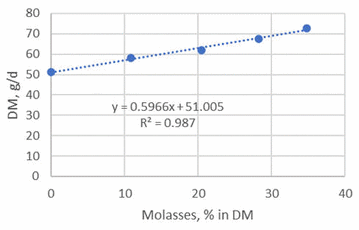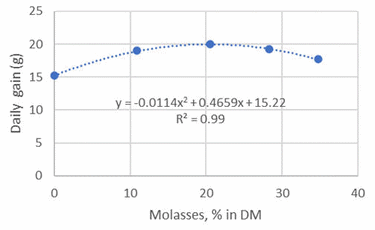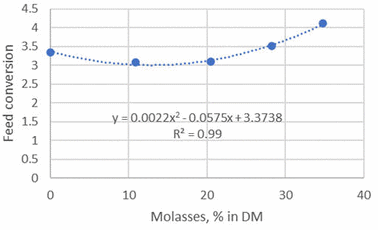

rabbits fed sweet potato foliage and soya bean waste
rabbits fed sweet potato foliage and soya bean waste

rabbits fed sweet potato foliage and soya bean waste
| Livestock Research for Rural Development 33 (7) 2021 | LRRD Search | LRRD Misssion | Guide for preparation of papers | LRRD Newsletter | Citation of this paper |
Supplementing a rabbit diet of sweet potato foliage and soya bean waste with up to 24% of molasses led to linear increases in feed intake. However, these changes were reflected in growth and feed conversion only up to the level of 20% beyond which the effect of the molasses was to reduce growth and feed conversion efficiency. The molasses level had no effect on carcass composition nor on meat quality but reduced the pH and increased the VFA in the cecum.
Key word: byproducts, carcass quality, cecal pH, VFA
In Vietnam rabbit production his being paid more attention by farmers and government agencies, as a means to improve the meat production and income ofsmall scale producers (Nguyen Van Thu, 2019). Rabbits have a high rate of reproduction, and their digestive system is adapted d to utilize fibrous diets. Conventional sources of protein such as soybean are expensive and have to be imported. We propose that an alternative feeding strategy is to feed forages such as sweet potato vines and soybean waste as the proten sourceand supplement them with enenergy-rich byproducts such as molasses tat has been effectively used as the energy source in diets for pigs and other livestock (Preston et al 1968; Preston and Leng, 1986).
The objective of this study was therefore to determine the the effect on growth of rabbits of feeding increasing levels of molassesin in a diet based on sweet potato vine and soybean waste.
The experiment was carried out in the rabbit farm at 474c/18, Long Hoa village, Binh Thuy district of Can Tho City and the laboratory E205 of Dept of Animal Sciences, Faculty of Agriculture, Can Tho University from Nov 2017 to May 2018.
Crossbred rabbits (Californian x local rabbit) for the experiment were produced at the rabbit farm. They were at 50 days of age with the live weight 703±51 g. Sixty rabbits were arranged in a completely randomized design with 5 treatments, corresponding to 5 molasses supplementation levels: 0, 6, 12, 18 and 24g DM/d. The rest of the diet was: sweet potato vines adl ibitm and 21 g DM/d of soybean waste. There were 3 replications. (cages) with 4 rabbits (balanced for sex) inn each experimental unit.
The rabbits were fed three times a daily at 8.00, 15.00 and 19.00h. Molasses was mixed with soya waste and fresh water was freely avilable.
Feeds and refusals were collected daily for proximal analysis (AOAC 1990), and NDF and ADF (Van Soest et al 1991). Metabolizable energy (ME) was calculated according to Maertens et al (2002), while ME of sweet potato vine was evaluated by NRC (1998). Feed intakes were recorded daily ad live weights weekly.. After finishing the feeding trial t all the rabbit were slaughtered for evaluating the carcass and meat quality. Cecal content was analyzed for l VFAs (Barnet and Reid 1957), N-NH3 (Kjeldahl) and pH s (pH meter 300 ries Bench).
Data were collected in Microsoft Excel soft ware, and then analysed by the One-way method of Minitab Soft ware 16.20 (Minitab, 2010). Polynomial equations (Microsoft Excel software) were fitted to the growth data.
Sweet potato vines and soya bea waste had similar concentrations of cude protein and fiber (Table 1).
|
Table 1. Chemical composition of feeds (%DM, except for DM which is on air-dry basis) |
||||||||||
|
Feed |
DM |
OM |
CP |
EE |
CF |
NFE |
NDF |
ADF |
Ash |
ME (MJ/kg) |
|
Molasses |
69.1 |
93.0 |
3.51 |
- |
- |
- |
- |
- |
6.99 |
15.4 |
|
Soya waste |
11.9 |
96.2 |
21.4 |
9.87 |
18.0 |
65.0 |
36.6 |
27.2 |
3.76 |
11.2 |
|
Sweet potato vine |
9.72 |
90.2 |
19.1 |
8.40 |
17.7 |
62.7 |
43.0 |
33.8 |
9.78 |
9.55 |
The reorded intakes molasses as percent of diet DM were slightly higher than the planned intkes (Table 3). Feed intake increased linearly as the proportion of molasses in the diet was increased (Table 2; Figure 1). However, the increase in intake was reflected in growth rate and feed conversion only up to the level of 20% molasses in the diet but then showed negative trends with further increases in molsses (Figures 2 and 3).
|
Table 2. Feed intake (g DM/d) of rabbits fed different levels of molasses |
||||||||
|
Item |
Molasses in the det, %* |
SEM / p |
||||||
|
0 |
6 |
12 |
18 |
24 |
||||
|
Sweet potato vine |
29.4 |
30.1 |
27.4 |
26.8 |
26.0 |
1.78/0.479 |
||
|
Soya waste |
21.7 |
21.9 |
21.8 |
21.5 |
21.4 |
0.10/0.051 |
||
|
Molasses |
- |
6.35a |
12.7b |
19.1c |
25.3d |
0.29/0.001 |
||
|
Total DM |
51.1a |
58.3ab |
61.9bc |
67.4cd |
72.7d |
1.65/0.001 |
||
|
Molasssses as percent of diet DM |
0 |
10.9 |
20.5 |
28.3 |
34.8 |
|||
|
*Planned per cent of diet DM |
||||||||
|
Table 3. Mean values for growth rate and feed conversion of rabbbits fed increasing levels of molasses in the diet |
||||||||
|
Item |
Molasses in the det, % * |
±SEM/p |
||||||
|
0 |
6 |
12 |
18 |
24 |
||||
|
Initial live weight (g) |
702 |
708 |
708 |
700 |
698 |
38.1/0.10 |
||
|
Final live weight (g) |
1768a |
2035b |
2110b |
2045b |
1935ab |
36.5/0.001 |
||
|
Daily gain (g) |
15.2a |
19.0bc |
20.0c |
19.2bc |
17.7b |
0.36/0.001 |
||
|
DM feed conversion |
3.35ab |
3.08a |
3.10ab |
3.51b |
4.12c |
0.09/0.001 |
||
|
* Planned per cent of diet DM abc Mean values with different letter in the same row ate different at p<0.05. |
||||||||
 |
 |
| Figure 1.
Effect of supplementary molasses on feed intake of rabbits fed sweet potato foliage and soya bean waste |
Figure 2. Effect of supplemente molasses on live weigt gain of rabbits fed sweet potato foliage and soya bean waste |
 |
|
| Figure 3. Effect of supplementar molasses on feed conversion of rabbits fed sweet potato foliage and soya bean waste | |
Carcass weights reflected the the final live wights of the rabbits (Table 4 -7), However, cuqualitiative traits (len meat percentage and chemical composition of the eat) wee nit affected by te moklasses level I the diet (Tables 5).
|
Table 4. Mean vailuesfor carcass and meat trauts inrabbits fed inccreasung levels of molasses |
||||||||||
|
Item |
Molasses in the det, % as DM* |
±SE/p |
||||||||
|
0 |
6 |
12 |
18 |
24 |
||||||
|
Live weight at slaughter (g) |
1800a |
2027bd |
2160c |
2100bc |
1920d |
22.5/0.001 |
||||
|
Carcass weight* (g) |
863a |
957ab |
1057b |
1007ab |
900ab |
32.3/0.017 |
||||
|
Carcass percentage (%) |
47.9 |
47.2 |
48.9 |
48.0 |
46.9 |
1.82/0.944 |
||||
|
Lean meat percentage (%) |
68.0 |
70.8 |
73.7 |
70.7 |
73.2 |
4.47/0.114 |
||||
|
*Planned per cent of diet DM. abcd Mean values with different letter in the same row ate different at p<0.05 |
||||||||||
|
Table 5. Chemical composition (% in fresh) of meat of rabbits fed different levels of molasses |
||||||||
|
Item |
Molasses in the det, %* |
±SEM/p |
||||||
|
0 |
6 |
12 |
18 |
24 |
||||
|
DM |
25.3 |
26.1 |
25.6 |
26.1 |
25.9 |
0.778/0.933 |
||
|
OM |
98.4 |
98.2 |
98.3 |
98.3 |
98.3 |
0.157/0.979 |
||
|
CP |
20.3 |
19.7 |
19.6 |
19.9 |
19.4 |
0.582/0.837 |
||
|
EE |
2.63 |
2.33 |
2.59 |
2.64 |
2.36 |
0.153/0.460 |
||
|
Ash |
1.62 |
1.76 |
1.70 |
1.67 |
1.67 |
0.157/0.979 |
||
|
*Planned per cent of diet DM |
||||||||
Molasses level did not affect the compositon of the stomach contents (Table 6) but led to reduced pH and higher concentration of VFA in the cecum (Table 8). These cha nges are similar to those induced in poultry by feedng of prebiotics and whiach area usually associated wit health benenefits in the host animal (Garcia-Curbela et al 2020).
|
Table 6. Chemical composition (% DM) of stomach content of rabbits fed different levels of molasses |
||||||||
|
Item |
Molasses in the det, % * |
±SEM/P |
||||||
|
0 |
6 |
12 |
18 |
24 |
||||
|
DM |
13.7 |
12.9 |
12.1 |
13.5 |
12.5 |
1.25/0.862 |
||
|
OM |
91.8 |
92.0 |
90.6 |
91.8 |
90.9 |
0.43/0.187 |
||
|
CP |
21.2 |
22.8 |
25.8 |
23.6 |
22.9 |
2.56/0.784 |
||
|
Ash |
8.18 |
7.98 |
9.37 |
8.24 |
9.07 |
0.43/0.188 |
||
|
*Planned per cent of diet DM
|
||||||||
|
Table 7. Chemical composition (% DM) of intestine content of rabbits fed different levels of molasses |
||||||||
|
Item |
Molasses in the det, %* |
±SEM/P |
||||||
|
0 |
6 |
12 |
18 |
24 |
||||
|
DM |
12.3 |
12.3 |
11.2 |
12.6 |
13.1 |
0.68/0.483 |
||
|
OM |
91.9 |
91.8 |
92.0 |
91.5 |
91.9 |
0.24/0.796 |
||
|
CP |
42.9 |
42.2 |
43.6 |
45.9 |
43.4 |
2.91/0.202 |
||
|
Ash |
8.14 |
8.16 |
8.04 |
8.46 |
8.13 |
0.24/0.793 |
||
|
*Planned per cent of diet DM DM: dry matter, OM: Organic matter, CP: crude protein, EE: Ether extract |
||||||||
|
Table 8. Chemical composition and parameters of the cecum content of rabbits fed different levels of molasses |
||||||||
|
Item |
Molasses in the det, %* |
±SEM/p |
||||||
|
0 |
6 |
12 |
18 |
24 |
||||
|
DM, % |
19.3 |
19.9 |
20.6 |
18.7 |
18.6 |
1.48/0.853 |
||
|
OM, % |
87.3 |
87.4 |
86.9 |
86.8 |
86.5 |
0.31/0.331 |
||
|
CP, % |
33.6 |
33.3 |
30.3 |
29.7 |
32.8 |
2.44/0.712 |
||
|
Ash, % |
12.7 |
12.6 |
13.1 |
13.2 |
13.5 |
0.31/0.327 |
||
|
pH |
6.60a |
5.70b |
5.65b |
5.70b |
5.76b |
0.11/0.001 |
||
|
N-NH3, mmol/L |
8.84 |
9.79 |
11.6 |
11.3 |
9.10 |
1.69/0.705 |
||
|
Total VFAs, mmol/L |
61.6a |
103ab |
111b |
93.7ab |
86.4ab |
9.57/0.047 |
||
|
*Planned per cent of diet DM ab Mean values with different letter in the same row ate different at p<0.05. |
||||||||
Supplementing a rabbit diet of sweet potato foliage and soya bean waste with up to 30% of molasses led to linear increases in feed intake. However, these changes were reflected in growth and feed conversion only up to the level of 120% beyond which the effect of the molasses was to reduce growth and feed conversion efficiency. The molasses level had no effect on carcass composition nor on meat quality but reduced the pH and increased the VFA in the cecum.
AOAC 1990 Official methods of analysis (15th edition), Washington 1, pp. 69-90.
Barnett A J G and Reid R L 1957 “Studies on the production of volatile fatty acids from grass by rumen liquor in an artificial rumen”, The volatile fatty acid production from grass, J. Agri. Sci. 48, pp. 315-321.
García Curbelo Y, Bocourt Salabarría R, Rodríguez Sanchez B, Albelo Dorta N, Albelo González A, Herrera Villafranca M and López Pérez M G 2020 Prebiotic effects of agavins in poultry. Livestock Research for Rural Development. Volume 32, Article #122. http://www.lrrd.org/lrrd32/8/yanelys32122.html
Maertens L, Perez J M, Villamide M, Cervera C, Gidenne T and Xiccato G 2002 Nutritive value of raw materials for rabbits: EGRAN tables 2002, World Rabbit Sci. 10, pp. 157-166.
Minitab 2010 Minitab reference manual release 16.2.0, Minitab Inc.
NRC 1998 Nutrient requirements of swine, National Academy Sciences, Washington, pp. 3-4.
Nguyen Van Thu 2019 Recent production status, research results and development conditions of rabbit production in Vietnam - A review. Can Tho University Journal of Science. 11(1): 30-35. DOI:10.22144/ctu.jen.2019.004
Preston T R, MacLeod N A, Lassota L and Velazquez M 1968 Sugar Cane Products as Energy Sources for Pigs. Nature, Volume 219, Issue 5155, pp. 727-728 (1968).
Preston T R and Leng R A 1987 Matching ruminant production systems with available resources in the tropics and sub-tropics, Penambul Books, Armidale.
Van Soest P J, Robertson J B and Lewis B A 1991 Methods for dietary fiber, and nonstarch polysaccharides in relation to animal nutrition. Symposium: Carbohydrate methodology, metabolism and nutritional implications in dairy cattle. J. Dairy Sci. 74, pp. 3585-3597.